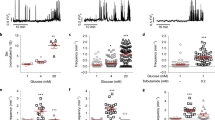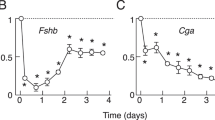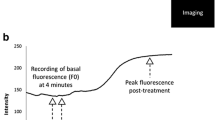Abstract
Secretory activity of the anterior pituitary gland is regulated by the brain through stimulatory and inhibitory substances released from nerve endings in the median eminence of the hypothalamus and carried by the adenohypophysial portal blood system to their respective target cells. These hypothalamic influences are modulated by the feedback action of peripheral hormones. Prolactin (PRL) secreting cells are, at least partially, under the stimulatory influence of thyrotropin releasing hormone (TRH)1,2 and of oestrogens3. However, they are mainly controlled by inhibitory substances among which dopamine (DA) is one of the most potent in vivo as well as in vitro4,5. The inhibitory effect of DA is reversed by oestrogen in vitro6. The mechanism by which these factors interact on their target cells is poorly understood. The recent discovery that anterior pituitary cells are excitable and that they are able to generate Ca2+-dependent action potentials has led to the suggestion that these effects are involved in a stimulus-secretion coupling at the membrane level7–9. In this paper, we report that DA inhibits both the spontaneous and TRH-induced action potentials in clonal PRL pituitary cells. In addition, oestradiol-17β is able to reverse the inhibitory effect of DA.
This is a preview of subscription content, access via your institution
Access options
Subscribe to this journal
Receive 51 print issues and online access
$199.00 per year
only $3.90 per issue
Buy this article
- Purchase on Springer Link
- Instant access to full article PDF
Prices may be subject to local taxes which are calculated during checkout
Similar content being viewed by others
References
Tashjian, A. H. et al. Biochem. biophys. Res. Commun. 43, 516–523 (1971).
Tixier-Vidal, A. et al. in Progress in Prolactin Physiology and Pathology (eds Robyn, C. & Harter, M.) 29–43 (Elsevier, Amsterdam, 1978).
Meites, J. & Nicoll, C. S. Proc. 1st Int. Congr. on Hormonal Steroids 2, 307 (1965).
Macleod, R. M. Endocrinology 85, 916–923 (1969).
Labrie, F. et al. in Central Nervous System Effects of Hypothalamic Hormones and Other Peptides (eds Collu, R. et al.) 207–234 (Raven, New York, 1979).
Raymond, V. et al. Science 200, 1173–1175 (1978).
Kidokoro, Y. Nature 258, 741–742 (1975).
Taraskevitch, P. S. & Douglas, W. W. Proc. natn. Acad. Sci. U.S.A. 74, 4064–4067 (1977).
Dufy, B. et al. Science 204, 509–511 (1979).
Gourdji, D. et al. Expl Cell Res. 82, 39–46 (1973).
Kitai, S. T. et al. Expl Brain Res. 24, 351–363 (1976).
Martin, S. et al. Endocrinology 92, 1084–1088 (1973).
McCaman, R. E. et al. Brain Res. 136, 141–147 (1977).
Schaeffer, J. M. & Hsueh, A. J. W. J. biol. Chem. 254, 5606–5608 (1979).
Kebabian, J. W. & Calne, D. B. Nature 277, 93–96 (1979).
Euvrard, C. et al. Brain Res. 169, 215–220 (1979).
Author information
Authors and Affiliations
Rights and permissions
About this article
Cite this article
Dufy, B., Vincent, JD., Fleury, H. et al. Dopamine inhibition of action potentials in a prolactin secreting cell line is modulated by oestrogen. Nature 282, 855–857 (1979). https://doi.org/10.1038/282855a0
Received:
Accepted:
Issue Date:
DOI: https://doi.org/10.1038/282855a0
This article is cited by
-
An Update on the Epidemiology of Schizophrenia with a Special Reference to Clinically Important Risk Factors
International Journal of Mental Health and Addiction (2011)
-
Evidence of a direct action of triiodothyronine (T3) on the cell membrane of GH3 cells: an electrophysiological approach
Experientia (1987)
-
Growth hormone-releasing factor reduces voltage-gated Ca2+ channel current in Rat GH3 cells
The Journal of Membrane Biology (1985)
Comments
By submitting a comment you agree to abide by our Terms and Community Guidelines. If you find something abusive or that does not comply with our terms or guidelines please flag it as inappropriate.



